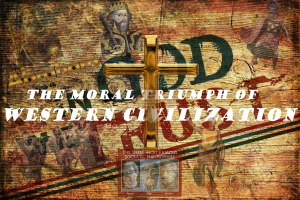 (Part 7 of a multi-part series on The Moral Triumph of Western Civilization.)
(Part 7 of a multi-part series on The Moral Triumph of Western Civilization.)
Charlemagne’s empire didn’t last long after his death in 814 as a new wave of pagan barbarians waged war against Christendom in the 9th century. Among the most well-known were the Magyars (migrants from central Asia), called Hungarians in Latin. They settled in the middle Danube region around 900.
Other barbaric Germanic tribes originating in Scandinavia called the Vikings (a.k.a. the Norsemen or Danes) burst out in virtually all directions. They went as far as Kiev (Russia) in 864, founded Iceland in 874 and even reached North America around 1000. They remained and settled in places like England and Normandy (France).
Gradually, most of this second wave of barbaric tribes were also assimilated into the Christian faith and became ‘civilized’ and were accepted into local villages.
Otto I, king of Aachen (Germany) and a Saxon, was crowned emperor of the (Holy) Roman Empire by Pope John XII in 962 a decade after marrying Adelaide, the queen of Italy and defeating her enemies. This now brought the Germanic kingdom closely linked with Italy and the Papacy.
Interestingly, just a year later Otto claimed the authority to oust the pope who put him on the throne. Otto replaced John XII with Pope Leo VIII. Otto is often called “Otto the Great” primarily for his important defeat of the powerful, pagan Magyars and his unifying of the many German tribes.
By about 1000, what we know now as Europe had now come into existence. Kingdoms in France, England, Scotland, Denmark, Norway and Sweden had taken form. In the east were Poland, Bohemia and Hungary. There were Christian kingdoms in northern Spain and independent city-states in Italy.
The following year (1001) Pope Sylvester II crowned Stephen I to be the first king of the Hungarians, who were now also brought into the Christian world. Poland, Bohemia and Scandinavia were also quickly converting to Christianity. The faith had now spread to all corners of Europe.
It was about this time that the division between Rome and Constantinople deepened. The Bishop of Rome (Pope) was still considered a western barbarian by those in Constantinople who, in turn, no longer recognized the ancient political structure that remained in the eastern center of Christianity. This schism within the Christian faith, that had been in the works for three centuries, finally came to fruition in 1054. The Christian world was now officially divided between the Roman Catholic and Greek Orthodox Churches.1
Most of those in Russia and the Balkans eventually converted to Christianity through Constantinople but remained mostly outside the influence of Rome and the West.
* * *
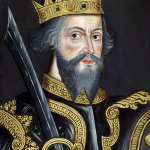
During the 9th and 10th centuries, the Germanic tribe known as the Franks permitted the settlements of Danish and Norwegian Vikings in a northwestern section of current day France.
These “North-men” eventually became known as Normans and the territory they inhabited as Normandy. They adopted the indigenous culture and converted to Christianity.
In 1002, there was an important intermarriage between the king of England and the sister of the Duke of Normandy. Their son, Edward, who had been exiled to Normandy ascended to the English throne in 1042. This gave the Normans a strong cultural influence in England.
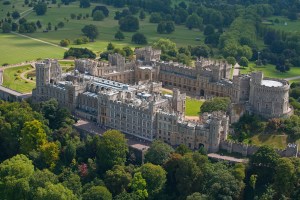
When Edward died without an heir in 1066 an enormous power struggle ensued. The English crown was claimed by one of England’s wealthiest aristocrats but was soon challenged by Duke William (“the Conqueror”) of Normandy who prevailed in the key Battle of Hastings. This was the last successful invasion of England.
The Normans ruled the island with considerable difficulty as the English refused to submit to his rule. But eventually, mostly as a result of intermarriage, “Anglo-Norman” culture developed. The blended language evolved into modern day English.
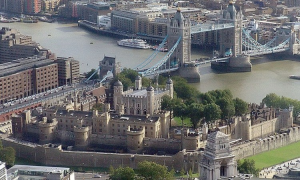
The Normans were culturally aggressive building more than 80 grand castles, previously non-existent during the reign of the Anglo-Saxons. These included the Tower of London and Windsor Castle. They also built numerous monasteries and enormous cathedrals like Winchester and Canterbury.
* * *
Many anti-religious, intellectual historians and philosophers have called the period between the fall of the Roman Empire and the Renaissance (about the 15th century) as the “Dark Ages” when (primitive, unenlightened) Christian expansion was in full bloom.2
Virtually all of the well-known European cities of today began between 1050 and 1200. With the “civilization” of the various barbaric tribal invaders populations grew rapidly. Peace became more commonplace giving farmers a new sense of security and the belief that they would actually be able to harvest what they’d sowed. People could now build houses and be able to pass them on to children.3 Roads still weren’t great but bridges were now built over rivers. Communications, commerce and trade increased.4 Previously uninhabited areas were cleared of trees and new villages constantly popping up.
The spread of Christianity placed a new divine value on all human life, including those who had been acquired in conquest. For the first time in human history, slavery finally began to have moral stigma. While the rest of the world was still capturing and enslaving, Europe was starting to develop new, creative ways to produce the energy required to replace forced human labor.
While a Christianized Europe was moving forward, most of the remainder of the world was stuck in neutral. With ample supplies of slaves, most conquering tribes were content to let slaves do the work so there was little incentive for work saving innovation.
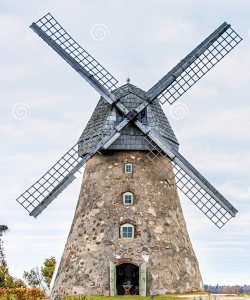
Moral considerations gave the impetus to the invention of energy producing devices like windmills and water wheels. A new, heavier plow was developed which allowed for a deeper furrow. New harnessing methods using horses were invented. With new farming methods, agricultural production soared requiring fewer agricultural workers allowing many to leave farms and take up new vocations in towns and villages.5
A common theme developed during these not-so “Dark Ages” that we’ll see again in this series particularly with the antebellum South in the United States many centuries later. Conquest produced slaves, slaves are considered the lowest, slaves do physical work — ergo, physical work was lowly. This is a key reason why historical elites considered sweat labor so beneath them.
This was especially true with the Romans and the fall of their empire. Plenty of slaves meant no requirement for physical work which produced sloth, little productivity and actual dependence. Aside from the hideous moral aspects of slavery, it quickly become enormously addictive — and destructive to those who enslave. Laziness and dependence eventually infect the slave holder. If necessity is the mother of invention, then lack of need is its executioner.
As we proceed through this series on Western Civilization, a common theme has emerged that will continue into the 21st century: Christianity > civilized men > peace > education > innovation > human advancement.
The change from a barbaric continent to a “civilized” one is likely one of the greatest accomplishments in all of history. The transformation of uber-violent, marauding, nomadic barbarians into peaceful, productive villagers was unprecedented in history. Only Christianity, in all of history, has been able to accomplish this. There is no other faith, ideology or belief that even comes close.
* * *
Theology is sometimes described as the “‘science of faith,’ or formal reasoning about God.”6 It focuses on understanding God’s nature, His demands of us, His intentions and His accomplishments (e.g., the natural universe). The goal of studying theology is to have a better understanding of what He has done, what He is going to do and what He expects of us, His unique creations.
Christian theologians have been plentiful and consistent throughout history. No religion in human history has been more scrutinized than Christianity. No book in history has been more studied and analyzed than the Christian Bible.
One of the earliest and most influential theologians was Augustine, an African who lived in the fifth century, during the last century of the Roman Empire. His book, City of God, is one of the most influential books in all of Christian history and was instrumental in nurturing the early beginnings of Western Civilization.
Caesar’s world was in turmoil at time of Augustine who wrote that there were really two cities: one on earth, one in heaven. The earthly city was under the dominion of the empire or state. Political authority, organization and administration were good for people to live safely in community. Such earthly authorities had no divine authority (like the Caesars claimed at the time).
Augustine said worldly governments were operated by fallible of people. The state could be judged, amended or changed. It would always be subordinate to heavenly authority. The “Western” world adopted the thinking of Augustine by separating the spiritual and political authorities after Caesar. Such separation was a new concept, like the idea of liberty was 1,500 years before that. “The idea that no ruler, no government, and no institution is too mighty to rise above moral criticism opened the way to a dynamic and progressive way of living in the West.”7
Augustine rejected astrology because any sense that our destiny is found in the stars differs from “God’s gift of free will.”8 He celebrated human achievement and progress. He wrote that God has provided “an inexhaustible wealth in … nature in which (we) can invent, learn, or employ… What wonderful—one might say stupefying—advances has human industry made in the arts of weaving and building, of agriculture and navigation!’”9 (City of God). This optimism was written more than 1,000 years before Columbus. Stunning.
Augustine said that God had given us (all of creation) a “rational nature” and urged us on to progress by advancing the human condition and discovering His amazing creation.10
* * *
1- Palmer, R.R. and Colton, Joel. A History of the Modern World. Alfred A. Knopf. New York. 1971.
2- Stark, Rodney. The Victory of Reason (How Christianity Led to Freedom, Capitalism, and Western Success). Random House Press, New York, 2005.
3- Palmer and Colton.
4- ibid.
5- Stark.
6- ibid.
7- Palmer and Colton.
8- Stark.
9- ibid.
10- ibid.

